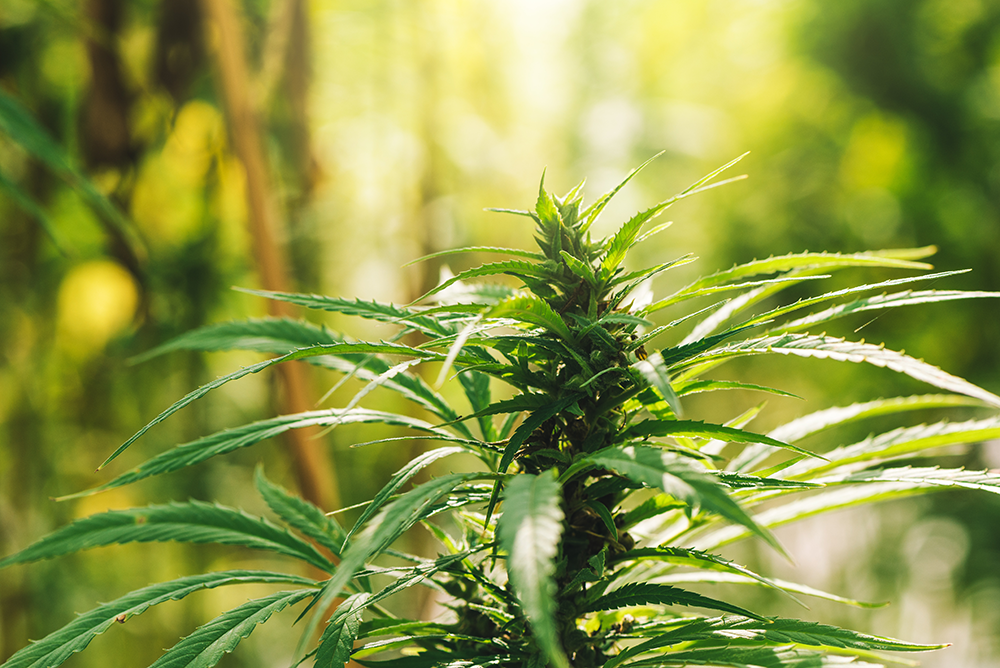
Keys to Maximizing Cannabis Yields: Light Intensity and Proper UV Radiation
Keys to Maximizing Cannabis Yields: Light Intensity and Proper UV Radiation
Humans have a long history with cannabis, with cultivation dating back millennia. Light is a crucial resource for plant growth. It is well known that the manipulation of light environment (e.g., Light intensity and spectrum) can substantially alter plant development. In indoor plant production, Light intensity and spectrum can be manipulated to achieve desired plant traits. Determining optimal Light intensity for indoor cannabis production is of particular interest since the costs relating to light energy make up a large component of the total energy consumption.
Cannabis is typically a short-day plant. The growth cycle of cultivated cannabis typically consists of three stages: propagation, vegetative growth, and flowering.
Cannabis Pflanzen
The vegetative stage is maintained under long days (e.g., 16-h to 18-h days), and the flowering stage is initiated under short days when a critical uninterrupted dark period per day is met, with commercial producers typically using a 12-h light and 12-h dark regime (Potter, 2014).
The advantage of indoor cultivation (vs. greenhouse or outdoor) is that it affords complete control over the lighting environment including the manipulation of light intensity (LI), spectrum or “quality”, as well as photoperiod. Cannabis growers alter the photoperiod to control the growing cycle, specifically to maintain the vegetative stage or trigger flowering (Leggett, 2006; UNODC, 2019). Controlled-environment cultivation allows growers to yield more crops per year than outdoor production in northern climates.
Suggested photoperiod and lighting PPFD of cannabis in greenhouse
Light intensity and spectrum modulate photosynthetic activity and photomorphogenic signals, which initiate processes such as cell division and elongation, directional growth and branching, all of which contribute to plant vegetative growth and development (Huché-Thélier et al., 2016). In indoor cannabis production, Light intensity is a controlled environmental input that has a major impact on plant photosynthesis, growth and yield.
Relation of light intensity and cannabis production
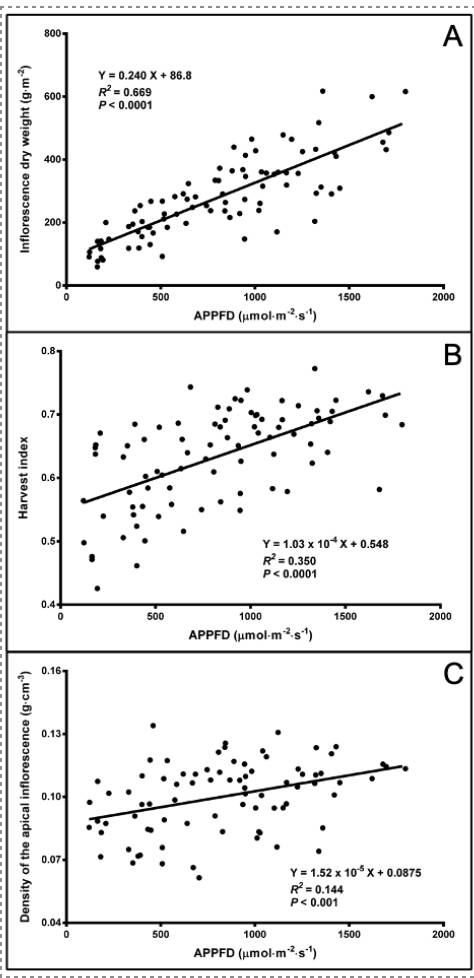
Growing crops with insufficient light (i.e., below “optimal,” as defined here) limits the yield potential, which in turn wastes the other production inputs including labour, water, nutrients and electricity. As lighting fixture is one of the most expensive investment of the production, what is the relationship between light intensity and yield?
Potter and Duncombe (2012) grew cannabis plants with varying canopy-level PPFDs during the flowering stage and found that increasing PPFD from 400 to 900 μmol·m−2·s−1 increased yield an average of 1.3 times higher, across seven cultivars, with no light intensity treatment effects on floral cannabinoid concentrations. Vanhove et al. (2011) found that cannabis yields were 1.3 to 3.1 times higher (depending on cultivar) when plants were grown under approximately 1000 μmol·m−2·s−1 compared to approximately 450 μmol·m−2·s−1 during the flowering stage.It was predicted that cannabis yield would exhibit a saturating response to increasing Light intensity, thereby signifying an optimum light intensity range for indoor cannabis production.
However, a new research from Morrison (2021), after 81 days‘ experiment, found that When plants grew under LI ranging from 120 to 1800 μmol·m–2·s–1 provided by light emitting diodes (LEDs), inflorescence yield increased linearly as LI increased up to 1800 μmol·m–2·s–1.

More and bigger inflorescences with high APPFD
Sketches of Cannabis sativa L. ‘Stillwater’ plants grown under low (A) and high (B) photosynthetic photon flux density (APPFD), 9 weeks after initiation of 12-h photoperiod Morrison (2021).
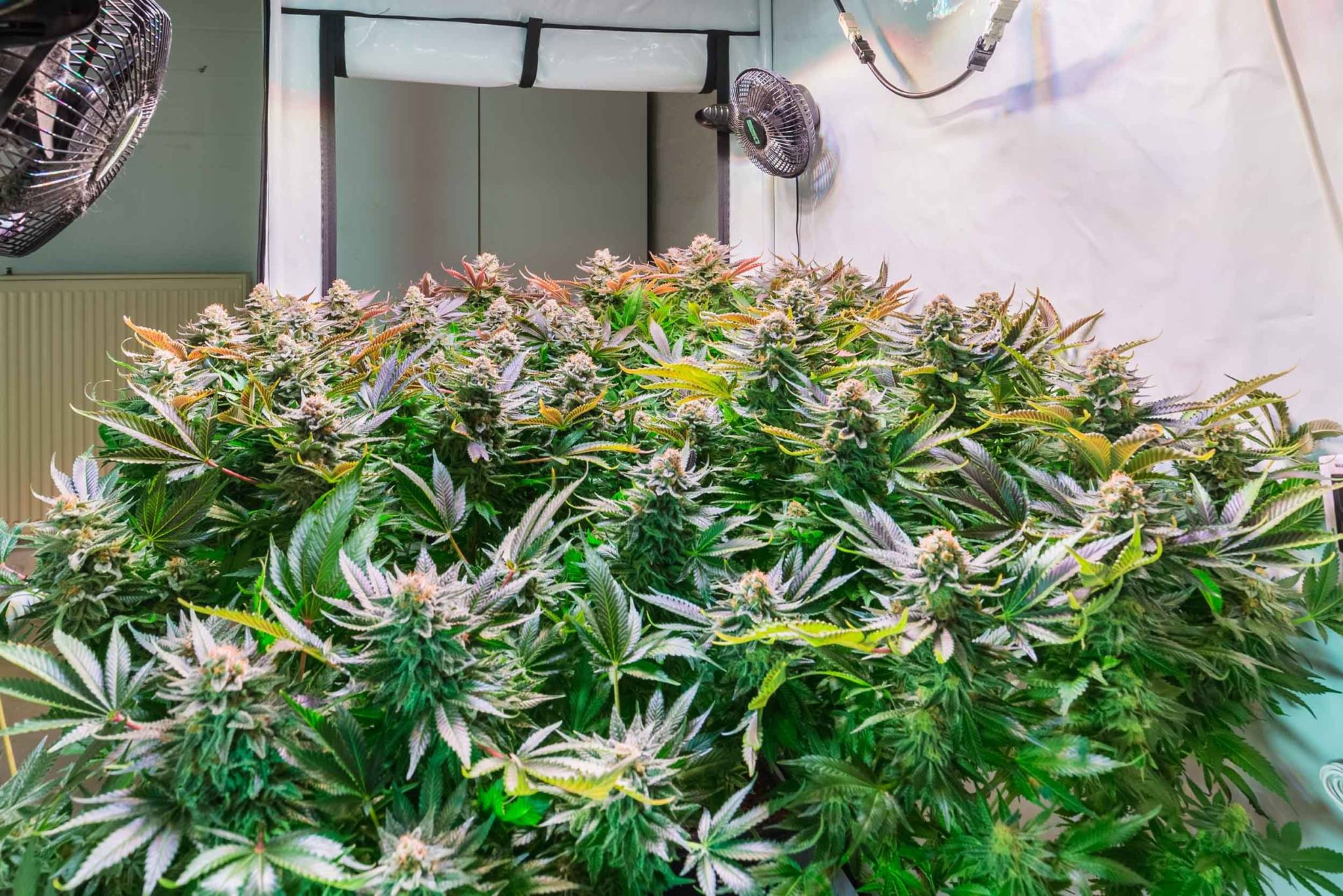
INCREASING LIGHT INTENSITY ENHANCES INFLORESCENCE QUALITY
The lack of a saturating yield response at such high Light Intensity is an important distinction between cannabis and other crops grown in controlled environments. This also means that the selection of an “optimum” Light Intensity for indoor cannabis production can be made somewhat independently from its yield response to Light Intensity. Effectively, within the range of practical indoor PPFD levels – the more light that is provided, the proportionally higher the increase in yield will be.
Effect of UV radiation on Cannabis photosynthesis, growth, and yield
Ultraviolet (UV) radiation in the solar spectrum is divided into three wavelength ranges: UVA
(315 to 400 nm), UVB (280 to 315 nm), and UVC (100 to 280 nm). The ozone layer of Earth’s atmosphere absorbs the harmful wavelengths of UVC and some wavelengths in the UVB band but allows UVA and some UVB wavelengths to reach ground level.
It is commonly believed that exposing cannabis plants to UV radiation can enhance Δ9-THC concentrations in female inflorescences and associated foliar tissues. Using horticultural science to test for optimal UV treatments in different species, UV radiation can be used to manipulate crops to attain desirable traits. UV radiation can modulate the expression of hundreds of genes, leading differential expression of plant metabolism, morphology and physiology (Jenkins, 2017). The application of UV radiation during cultivation is an area of interest in the cannabis industry for its purported potential to increase cannabinoid concentration in mature female cannabis inflorescences tissues (hereafter, inflorescences).
More UV Light More yield? Here is what researcher found.
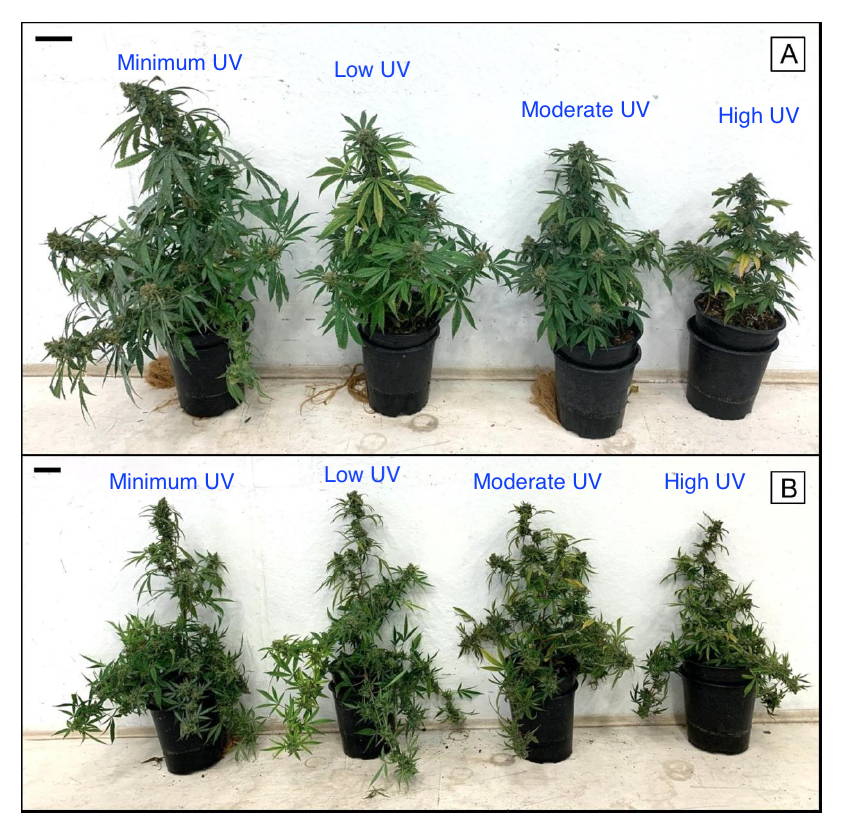
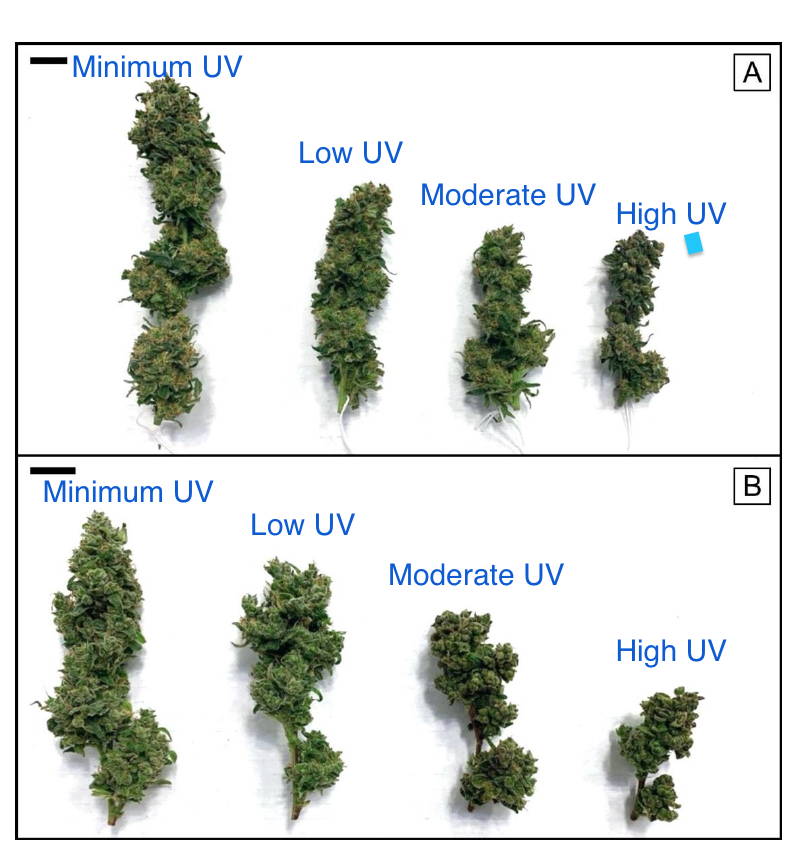
Gross plant morphology of (A) ‘Low Tide’ and (B) ‘Breaking Wave’ Cannabis sativa L. plants grown under (from left to right) minimum, low, moderate, and high UV exposure levels. Images were taken just prior to harvest (i.e., 9 weeks after the initiation of UV treatments). Note the white spots (powdery mildew) on the adaxial sides of leaves on the far-left plants. The black scale bar at the upper left of each image is 5.0 cm. Morrison (2021)
The apical inflorescences of (A) ‘Low Tide’ and (B) ‘Breaking Wave’ Cannabis sativa L. plants grown under (from left to right) minimum, low, moderate, and high UV exposure levels. Images were taken at harvest (i.e., 9 weeks after the initiation of UV treatments). The black scale bar at the upper left of each image is 2.0 cm. Morrison (2021).
This study provided insight into the sensitivity of cannabis to relatively short-wavelength UVB radiation (including a small proportion of UVC) and long-term UV exposure. Increasing UV exposure levels generally had negative impacts on cannabis plant growth, inflorescence yield, quality, and secondary metabolite composition.
MORE UV RADIATION MAY SUPPRESSES CANNABIS GROWTH AND YIELD
Long-term exposure of various intensities of relatively short-wavelength UV radiation had generally negative impacts on cannabis growth, inflorescence yield, and inflorescence quality. Any horticultural UV treatment protocol is comprised of a myriad of factors including: time of application in the plants’ life cycle, number of days of application, number of hours per day (including pulsed methods), time of day with respect to the PAR photoperiod, spectrum, and intensity. UV radition can improve the THC and CBD content of a plant if it is used properly.
Proper usage of UV radiation may increase Cannabinoid and THC Production
Ultraviolet light causes the production of resin, and with it THC and CBD, in order to protect the marijuana plant from harmful UV rays. Thus, adding UV light to LED grow lights results in an increase in THC in the resulting buds.
It is commonly believed that exposing cannabis plants to UV radiation can enhance Δ9-THC concentrations in female inflorescences and associated foliar tissues. However, not all UV light is beneficial though. Too much UV light may decrease CBD content, uppresses cannabis growth and yield.
Proper usage of UV radiation can increase Cannabinoid and THC Production. When making the decision to utilize UV wavelengths (as with any production technology) in indoor cannabis production, the positive crop outcomes must outweigh factors related to the cost of deploying the technology including infrastructure and energy costs, fixture lifespan, and health risks that UV radiation could pose to employees. While UVB LEDs in particular (Kusuma et al., 2020) and UV lighting technologies in general are less energy efficient than modern horticultural PAR fixtures (Nelson and Bugbee, 2014), fluence rates in the UV spectrum are typically many times lower than the PAR spectrum.
Engel Lighting has cooperated with different research institutes developed a special spectrum for increasing cannabis’s yield. It has proper UV radiation with optimised Light Intensity. Engel Carpo spectrum not only makes sure your crops get sufficient light, but also maximize the yields with a reasonable electricity costs.
Potter, D.J. (2014). A review of the cultivation and processing of cannabis (Cannabis sativa L.) for production of prescription medicines in the UK. Drug Test. Anal. 6:31–38. doi: 10.1002/dta.1531.
Leggett, T. (2006). A review of the world cannabis situation. Bull. Narc. 58:1–155.
United Natns Office on Drugs and Crime (UNODC). (2019). World Drug Report 2019. New York, NY: United Nations.
Huché-Thélier, L., Crespel, L., Gourrierec, J. Le, Morel, P., Sakr, S., Leduc, N. (2016). Light signaling and plant responses to blue and UV radiations: Perspectives for applications in horticulture. Environ. Exp. Bot. 121:22–38. doi: 10.1016/j.envexpbot.2015.06.009.
Vanhove, W., Van Damme, P., Meert, N. (2011). Factors determining yield and quality of illicit indoor cannabis (Cannabis spp.) production. Forensic Sci. Int. 212:158–163. doi: 10.1016/J.FORSCIINT.2011.06.006.
Jenkins, G.I. (2017). Photomorphogenic responses to ultraviolet-B light. Plant Cell Environ. 40:2544–2557. doi: 10.1111/pce.12934.
Kusuma, P., Pattison, P.M., Bugbee, B. (2020). From physics to fixtures to food: Current and potential LED efficacy. Hortic. Res. 7:56. doi: 10.1038/s41438-020-0283-7.
Nelson, J.A., Bugbee, B. (2014). Economic analysis of greenhouse lighting: Light emitting diodes vs. high intensity discharge fixtures. PLoS One. 9. doi: 10.1371/journal.pone.0099010. io

Einen Kommentar hinterlassen